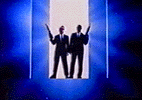
Directed by Barry Sonnenfeld
Physical Effects Supervised by Peter M.
Chesney

Directed by Barry Sonnenfeld
Physical Effects Supervised by Peter M.
Chesney
 Visual Effects Produced by:
Visual Effects Produced by:
INDUSTRIAL LIGHT & MAGIC [~250 shots]
Visual Effects Supervisor: Eric Brevig
Visual Effects Producer: Jacqueline M. Lopez
Director of Animation: Rob Coleman
VISIONART, Supervisor: Joshua Rose
AUTUMN LIGHT ENTERTAINMENT
VCE
RICK BAKER'S CINOVATION STUDIOS
STEVE JOHNSON'S XFX
KNB EFX GROUP
ME*FX
 
|
 
|
Nominated for two 1997 VFX HQ Awards: Best CG Character Animation and Best Miniature Pyrotechnics.
MEN IN BLACK features almost 250 visual effects
from Industrial Light & Magic and makeup and
creature effects supervised by Rick Baker. The film stars Will Smith and Tommy Lee
Jones as top secret "immigration" cops chasing aliens on Earth.
The film contains a generous helpings of CG character animation, bluescreen
composites, miniature work, wire and rig removals, and an immense amount of
live-action creature effects, produced by Baker's Cinovation Studios, Steve Johnson's
XFX, KNB EFX Group and ME*FX.
Things kick off quickly with the opening sequence; the camera tracks a small, alien
dragonfly zipping around the desert at night, only to be slammed against the
windshield of a passing van. The bug animation is wonderful to look at, especially
as the camera follows it against the moon--the nearly three minute sequence produced by Autumn Light Entertainment is quite pretty.
The audience is immediately introduced to Mikey, an alien posing as an illegal alien.
Mikey takes off his disguise, revealing an enormous, ugly, multi-handed
extra-terrestrial, realized both by an elaborate, on-set suit, and as an ILM computer
generated character. The CG model of Mikey is highly intricate, and was used for
full motion shots of Mikey attacking a trooper. Especially nice was the detail
created and animated in Mikey's mouth and jaws.
A spectacular shot, one the most riveting of the film, occurs as Tommy Lee Jones
blows the head off of Jeebs (Tony Shaloub), a jeweler who is actually an alien posing
as a human. The transformation is remarkable--a small, stubby head appears and
morphs and melds itself into Shaloub's normal-sized head in the amazing seven second
shot. Tony Hudson at ILM supervised both the modeling and animating tasks of this
sequence.
Perfectly illustrating the visual differences between on-set puppets and CG animation
are the "worm guys," four tiny, slimy aliens that assist the MIB unit. In an early
sequence, the aliens are depicted as Rick Baker rod puppets, but later in the film,
they show up as ILM CG effects. The difference? In the rod puppet scene, the
aliens' movement is quite limited. Sure, the camera has complete freedom in the
puppets' case, since no digital manipulation of the shot is required. But the two
later ILM CG shots of the "worm guys" walking around the headquarters are much more
dynamic and visually interesting.
ILM's CG unit succeeds once again as an alien disguised as a small pug dog, who has a
conversation with Tommy Lee Jones. In much the same way Rhythm & Hues used CG animation to make animals talk
in the Academy Award winner, BABE, the dog's lower jaw was digitally removed and
replaced with a fully CG jaw, synched to the alien's lines. The articulation of the
mouth is superb.
The character receiving the most of ILM's treatment, however, is Edgar, the nasty
bug-like alien whose intent is to allow the Earth to be destroyed. With the aid of
some excellent makeup and CG effects, the huge alien hides inside a human's skin.
Early in the film, with the skin sagging on his face, Edgar (Vincent D'Onofrio) pulls
back his skin in a distinctively unhumanlike manner. The effect, an ILM creation, is
mind-blowingly effective, reminiscent of ILM's dazzling mask work in MISSION: IMPOSSIBLE.
Edgar finally reveals himself at the end of the film as a huge, fifteen foot tall
alien. Cinovation designed and produced a full-scale animatronic Edgar-alien;
however, because of script and design changes, the entire sequence was handed to ILM
to be executed as CG animation in post production. The character animation shines in
this final sequence, with background plates taken from moving cameras that dolly,
crane, shake, rattle and roll... and the CG creature was match-moved perfectly.
Director Barry Sonnenfeld's trademark frenetic camera movements were not dulled down
for the extensive CG sequence. ILM's achievement in animation and match-moving can
now allow directors to shoot in the same style they would shoot a non-CG sequence,
giving the director full creative control over a scene, instead of the technology
dictating the creative decision, as it has done in the past.
The film ends with an absolutely incredible shot--the ultimate zoom out. Starting
from a closeup of a N.Y. city street, the camera pulls back revealing the Earth, the
solar system, the galaxy, revealing that our own galaxy is just a game to another
race of aliens. The extraordinary shot has to be seen to be believed. The sequence,
overseen by ILM's Scott Farrar, contains an enormous amount of
CG elements, and although it seems a bit synthetic at times (especially with the
alien hand that rolls the marbles), the shot should be remembered as one of the most
incredible closing shots in movie history.
 
|
 
|
Check out Cinefex 70.
Check out American Cinematographer June '97 and Dec. '97.

. . VFX HQ Produced by Todd Vaziri . . http://www.vfxhq.com . . e-mail: tvaziri@gmail.com . .
All text Copyright © 1998 Todd Vaziri, unless otherwise noted